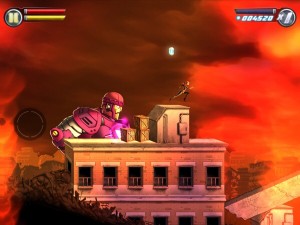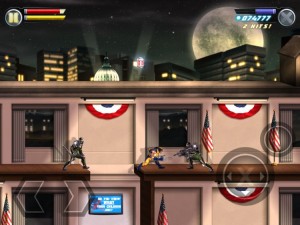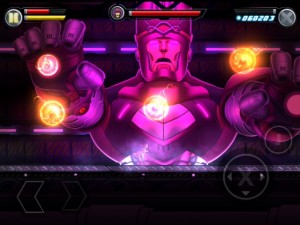With 20th Century Fox’s recent X-Men: Days of Future Past film currently in theaters, one might expect to go to the iTunes Marketplace and find a tie-in game based on the latest film directed by Bryan Singer. Although someone conducting such a search would quickly discover Uncanny X-Men: Days of Future (out now $2.99), I am going say right now that this game — despite having some similarities — isn’t based on Fox’s recent film. Instead, GlichSoft’s recent mobile game — with Kitty Pryde at the helm, rather than Wolverine — is actually a far more accurate adaptation of Marvel’s 1981 comic book masterpiece (written by the renown team of Chris Claremont and John Byrne).
 In a future where giant robots, known as Sentinels, have either killed mutants everywhere — or in some cases placed them within internment camps — Kitty Pryde and friends were attempting an escape that went horribly wrong. Their botched effort led to Kitty finding a modified Sentinel made Cerebro — designed for hunting down mutants — that didn’t quite work as desired when she hooked herself up, instead linking her mind with her past self. Realizing what had just happened to herself, she then convinces the X-Men to help her past self in a crusade to prevent Mystique from completing a high profile assassination — of Senator Kelly — that would kick off the chain of events leading up to her dark future.
In a future where giant robots, known as Sentinels, have either killed mutants everywhere — or in some cases placed them within internment camps — Kitty Pryde and friends were attempting an escape that went horribly wrong. Their botched effort led to Kitty finding a modified Sentinel made Cerebro — designed for hunting down mutants — that didn’t quite work as desired when she hooked herself up, instead linking her mind with her past self. Realizing what had just happened to herself, she then convinces the X-Men to help her past self in a crusade to prevent Mystique from completing a high profile assassination — of Senator Kelly — that would kick off the chain of events leading up to her dark future.
Now before I begin discussing the game’s mechanics, it would probably be beneficial for everyone involved if I first cleared up some matters involving concerns most of you probably have. Uncanny X-Men: Days of Future Past is a 2-D Platformer — coupled with Beat’em Up action — that might remind some people of the famous X-Men games that were released long ago on the Sega Genesis, and furthermore has no IAPs whatsoever. With this fact finally covered, and people no longer having to worry if this tie-in game features any similarities to what normally passes for a licensed app released on iTunes these days, I can now finally move on to covering the actual game play.
The first decision one is going to have to make with Uncanny X-Men: Days of the Future Past is whether they wish to use an on-screen button enabled control scheme, or one based on motion gestures. For the virtual button based method the player will have left and right buttons on the screen’s left hand side, while there will be a jump and action button placed on the device’s opposite end. I am going to admit right now that the virtual button method is what I used predominantly during my time with Uncanny X-Men: Days of Future Past, so I only have limited things to say about the other format.
 The function of the left and right buttons are — as you have probably already guessed — for moving your currently selected X-Men left or right, where as the jump button is used for having them perform both jumps and double-jumps. Meanwhile, tapping the action button will normally cause your current character to perform and endless attack — even if they should happen to be mid-air at the time — so long as you continue to wail away. There are also special attacks performed by swiping either down, forwards, or backwards across this button — which will sometimes even factor in whether or not you’re currently jumping — but these additional options exist purely on a character-by-character basis.
The function of the left and right buttons are — as you have probably already guessed — for moving your currently selected X-Men left or right, where as the jump button is used for having them perform both jumps and double-jumps. Meanwhile, tapping the action button will normally cause your current character to perform and endless attack — even if they should happen to be mid-air at the time — so long as you continue to wail away. There are also special attacks performed by swiping either down, forwards, or backwards across this button — which will sometimes even factor in whether or not you’re currently jumping — but these additional options exist purely on a character-by-character basis.
The control scheme works most of the time, leaving me generally happy with the results that I received from it (although I did occasionally have issues getting some of the mutant powers to fire on the first try). Although I am not entirely sure how well the alternate control scheme — which is actually turned off by default — performs during some of the game’s more challenging situations, I do have a basic idea of how it works as well. Sliding a finger across the screen’s left hand side controls your lateral movement; where as tapping on the right hand side is for attacking, swiping up is for jumping, and the various mutants powers are activated by swiping in exactly the same direction as before.
With these controls you’ll pilot your various X-Men through the game’s selection of 23 sizable stages, as you platform jump — enemy bash — and boss thrash your way to victory against the impending future nightmare. You’ll have quite a selection of X-Men as well — whom can freely be swapped mid stage — with the current roster including: Kitty Pryde, Wolverine, Cyclops, Colossus, and Scarlet Witch. Initially you’ll start with only Kitty and Wolverine — with more unlocked during the course of the game’s plot — but GlitchSoft has further promised a patch to add Magneto, Storm, and Polaris in the near future.
 Smashing in the faces of enemies — breaking various bits of scenery — as well as the glowing blue canisters that you can find all over the place will award the player with valuable EXP, which is the currency through which your various X-Men are upgraded. As long as you continuously beat stuff up — without getting hit along the way — a combo gauge will continue to fill up, which can multiply the effectiveness of each EXP pick up by a factor of up to nine times. Particularly thorough players will even manage to find giant caches of EXP canisters — as well as comic books — hidden within special secret areas, which will generally be easier to locate with the game’s more agile characters.
Smashing in the faces of enemies — breaking various bits of scenery — as well as the glowing blue canisters that you can find all over the place will award the player with valuable EXP, which is the currency through which your various X-Men are upgraded. As long as you continuously beat stuff up — without getting hit along the way — a combo gauge will continue to fill up, which can multiply the effectiveness of each EXP pick up by a factor of up to nine times. Particularly thorough players will even manage to find giant caches of EXP canisters — as well as comic books — hidden within special secret areas, which will generally be easier to locate with the game’s more agile characters.
Curiously — without any deliberate level replaying — I was able to completely max out three of the game’s five currently available characters, which — coupled with some other factors — has led me to having some thoughts. As there is a small cost to continue levels — although restarting them is free — and the occasional loading screen tooltip also reminding you that everything can be unlocked in game for free, it seems obvious what happened. Odds are that Days of Future Past was originally intended to have IAPs, but the existence of any such purchases was likely fully eradicated at around the eleventh hour (which is good, as the game probably would not have done well under the weight of bad grinding).
Anyways — as I previously mentioned — hidden about the various stages will be secret comic books, which unlock lore entries — such a game concept art, and classical X-Men comic covers — when successfully collected. Furthermore — if you successfully get a three star rating by a stage’s end — you will furthermore receive one of twenty three character bios, which detail the character’s history during both the past and present timelines. Getting one of these 3-Star ratings involves defeating most of a stage’s enemies, collecting most of the available EXP canisters, and successfully keeping your health bar above a certain level (naturally this is easiest done using Wolverine’s healing passives).
 With all of the game’s various mechanics now finally covered, it’s finally time that I set about to discussing what Uncanny X-Men: Days of Future Past has specifically done right and wrong (and there are certainly entries for both columns).
With all of the game’s various mechanics now finally covered, it’s finally time that I set about to discussing what Uncanny X-Men: Days of Future Past has specifically done right and wrong (and there are certainly entries for both columns).
The biggest item in the correctly done category would definitely have to be the game’s visual presentation, since — particularly during the various cut scenes — Days of Future Past really makes you feel as though you’re playing through a living comic book. Especially nice touches on this front would be the main title screen, as well as the character selection screen, which cleverly recreate various iconic comic covers from the original 1981 story-arc. Further accompanying all of this are an array of lighting and shadow effects, ensuring that every environment — whether it be the Danger Room, or perhaps just the Savage Lands — always looks interesting and dynamic at all times. I also appreciate that the game was never afraid of embracing some of the series’ weirder moments, such as having one of Kitty’s unlocks adding Lockheed as a permanent helper.
Unfortunately, although the game goes the full nine yards in being a treasure trove of fan pleasing nostalgia, the actual game play of Uncanny X-Men: Days of Future Past isn’t quite as flawlessly executed. Although the controls usually worked okay — and I didn’t have much difficulty finishing the adventure — there were various points where the game just didn’t want to respond as fast I needed it to, leading to some unnecessary deaths. Furthermore — upon unlocking permanent access to Lockheed — I had a ton of crashes and slowdown whenever I was playing Kitty Pryde, especially during the entire Savage Lands level sequence. I don’t know what is causing this — whether it be due to poor optimization involving Lockheed, the Savage Lands, or perhaps both — but I wasn’t particularly amused since Lockheed is currently the most expensive power up to actually unlock.
However — to be sure — I want to make it clear that Uncanny X-Men: Days of Future Past is not bad by any means whatsoever, it’s just that there’s currently still some significant room from improvements from GlitchSoft. The app currently lacks the game play tightness of their previously developed He-Man: The Most Powerful Game in the Universe (our review), with the trade off being that you don’t have any of the IAPs either. However — fear not — for there is still great hope of this well made game becoming even better in the near future, as GlitchSoft has already confirmed that there are at least two major patches arriving in the near future.
iFanzine Verdict: With its dynamic visuals, constant accurate references to various facets of the X-Men cannon, and its over all very accurate portrayal of the relevant plotline — especially compared to Fox’s movie — there is much here for x-fans to enjoy. The game furthermore lacks any of the IAP issues we previously mentioned in GlitchSoft’s He-Man: The Most Powerful Game in the Universe, but sadly lacks the same tightness of game play and optimization that the previous game had as well. GlitchSoft’s Days of Future Past is certainly not a bad game by any means, but there is currently some room still for future improvements (which just might be on the way, since the developer has already confirmed the existence of at least two future patches).


